It’s easy to see that Oath, currently in development within Leder Games, was on many people’s most-anticipated list for PAX Unplugged 2019. Every time it was on the single demo table set aside for it, a crowd of at least twenty people pressed together, trying their best not to block the flow of foot traffic on the expo floor as they leaned in to hear talks about the game’s intent and glimpse some gameplay. I was lucky enough to be able to demo the game with its designer, Cole Wehrle, who’s been on something of a roll lately with no shortage of praise received for both Root and Pax Pamir’s second edition. So when the much promised next act showed up, in which the history of all previously played struggles affects future games, a cascade of possibilities, well you can see how everyone was champing at the bit to learn how this game would play.
Please note that all components shown here are not final. As good as things are looking already, this is not the final iteration of Oath. Any rules discussed here are, of course, also subject to tweaks and changes.
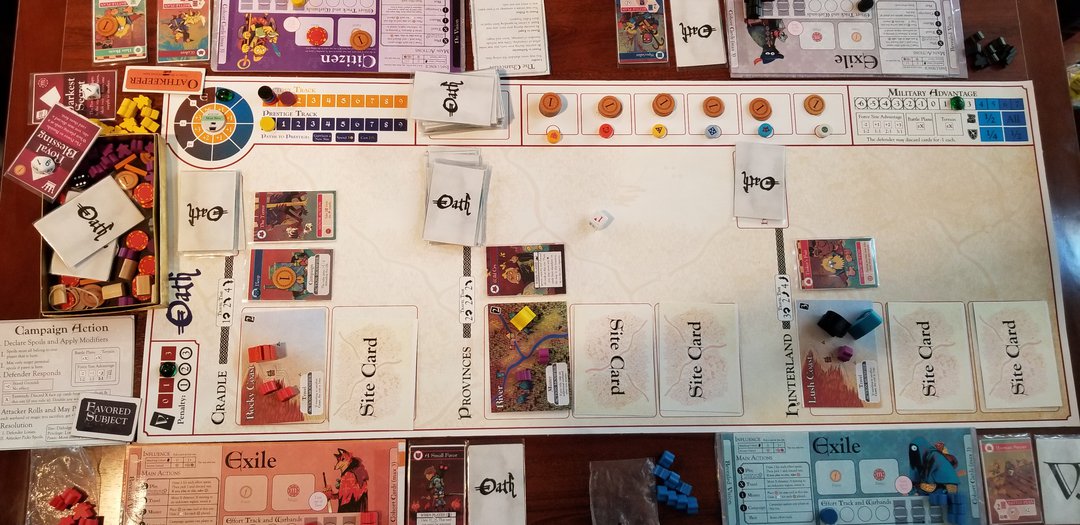
Board overview in its current form. It looks like a lot, but you'd be surprised just how compact everything is. This is less of a table hog than Root.
A Conflict Never Before Seen
The question is where to begin. Oath quite literally gives you everything. So for the folks who may be hearing about this game for the first time, I’ll start at the beginning. Oath is game centered around a land of beautifully illustrated, non-standard fantasy races as they vie for power. That could take the form of maintaining their republic, a betrayal that sends the empire into disarray, warring states competing for supremacy, or a shadow war of conspiracies and overthrows. For each game you play, the character of your world will change and adapt based on who won and how they won. Everyone’s copy of Oath will be different after several plays. Yet Cole is very careful not to call this a Legacy game. It isn’t. Inside this box you won’t find any stickers, or markers to write on the board, or be asked to tear up any cards. In fact, one of the selling points of this game is that you can reset it to fresh-out-of-the-box at any time. It also supports drop-in, drop-out play so you don’t have to worry about dedicated play groups.
How does the game accomplish this shifting world? Through a deck of multi-purpose cards that represent the land’s denizens and how you can recruit them for your cause! Each game you’ll only cycle through about a third to half of the deck, and from those discarded during the course of the game you’ll cycle out several cards and cycle in more from a box of over 200. Again, the cards that cycle in are a direct result of the prior game, perhaps pertaining to a particular faction or card used. This also means that if something remains hidden in the deck for several games, never cycling out, it might resurface at a later date; for example, a lost relic from the fall of the old empire might be rediscovered generations later by rebels seeking to unite the kingdom once again. I should mention that while Oath doesn’t have any narrative elements like a book of tales to read from, it is heavily thematic and you’ll find it tells great stories all the same.
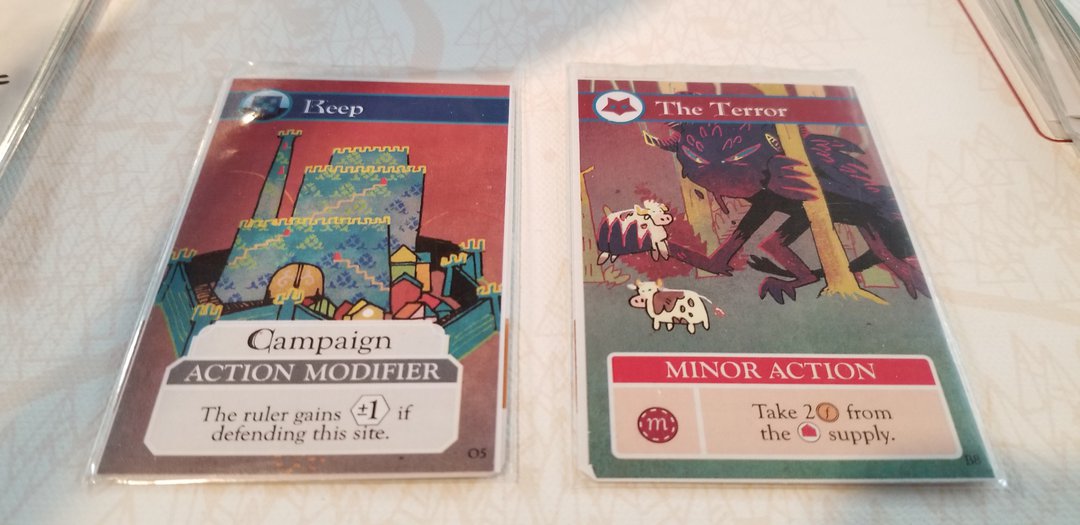
I think Kyle's art style is becoming synonymous with Leder Games's image!
Looking at the familiar, evocative art style of Kyle Ferrin and seeing that deck of denizen cards, you might be thinking by now that this is just some hyped up version of Root on steroids. So let me stop you right there. While I can see similarities, such as the aforementioned deck of cards, this game is by no means Root 2.0. In fact, I see design elements of Pax Pamir’s 2nd Edition and even Dune in here as well as some truly novel concepts. Though I’m getting ahead of myself. First we need to talk victory. How do you win a game of Oath?
The most straightforward way you can win is by fulfilling whatever the public objective is for the game, netting you a set amount of victory points each time you achieve it. If the game timer ends, and you’re in the lead, congratulations! The game timer, by the way, runs a minimum of 5 turns but variably can end after 8 with an increasing chance on a die roll each turn. In our game, the standard score objective took the form of controlling the most territories at the end of each game round, but this objective can, and will, change depending on how your last game ended. However, there are also Vision cards in the deck, a bit like Root’s Dominance cards, that give alternative win conditions, netting you the game immediately if you fulfill them. Some reward you for holding territories or possessing certain power-up cards that are public to everyone (and can be stolen by other players).
Unlike Dominance cards which are responsible for about 10 to 15% of Root wins, according to Cole, Vision cards account for roughly 50% of Oath wins. You’re just as likely to win by Vision as by points. Yet they remain constant from game to game, so you always know what they are and how to play around them. Also, they only trigger once three Vision cards have been drawn, giving you a definite timeline in which you can prepare for their possible entrance. Finally, because they have different card backs, you always know when a player is holding a Vision. Ignore the possibilities at your own risk.
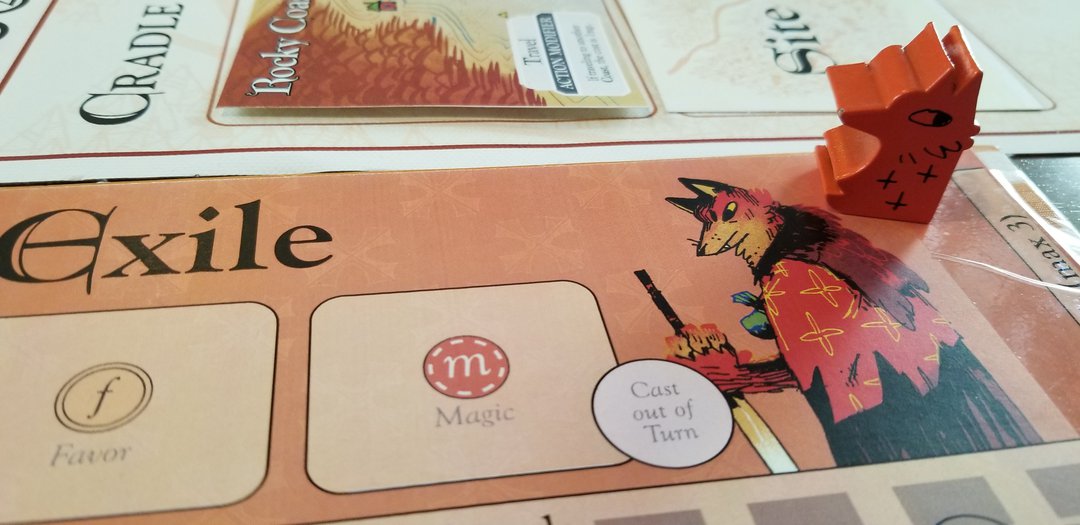
The player pawns are chunky and have a big presence on the board. I'm calling dibs on these sneaky fox warriors every darn time I play this game!
Influence And Innovation
Previously, I mentioned similarities to some other board games, like Pax Pamir. This is a good point to introduce the concept of the chancellor and citizens. One player each game takes the role of the chancellor, the ruler of the current regime, and they are given some special powers at the cost of less actions per turn. In addition to some bonuses for policing the other “exile” players, if their competition ever gets too strong they can offer a deal to those players. Should those players accept, they become loyal citizens of the empire, working on the same team as the chancellor. In this case when the game ends, and if the citizen team has the most victory points, the citizen with the most prestige wins (a second track that behaves similarly to Pax Pamir’s scoring mechanism). It’s entirely possible that a fearful ruler will try to keep an enemy close only to find themselves usurped from within! In a twist, the chancellor can kick out their competition, setting them back to zero points and “exile” status once again, but only if they can pay for it. And the cost? It’s how much favor that player currently has with the populace. The cards they’ve played (limit 3) each grant standing according to their suit, symbols matching the six factions within the population (in addition to any abilities gained from playing them). A ruler who can’t erode public support for their adversaries may find themselves unable to unseat the competition and be ousted instead.
I’d also mentioned the game has a little Dune DNA in it, which is my segue to mentioning combat. This is one area in which Oath departs heavily from Root. In Root, combat can take several turns and represents a skirmish between two sets of forces. In Oath, a campaign action can sweep a little as one location or every single enemy territory belonging to a player, and the resolution is decisive! You decide how big a campaign you wish to wage when you attack. You take penalties the more zones you attempt to grab, so you’ll need bigger and bigger forces or more savvy battle tactic cards giving you boosts. That Dune-like decision comes when your forces plus your bonuses and a die roll still don’t result in enough success to boost you to the goal you seek; you can kill off your own troops at the cost of one meeple per space on the combat track until you bump up into the level of success you want. Of course, you’ll still need to leave someone alive to garrison the new territory or it’s not under your control, so how many forces are you willing to sacrifice in your quest for victory? If you’ve ever wanted to play a game where pyrrhic victories were driven home like no other, now you can.
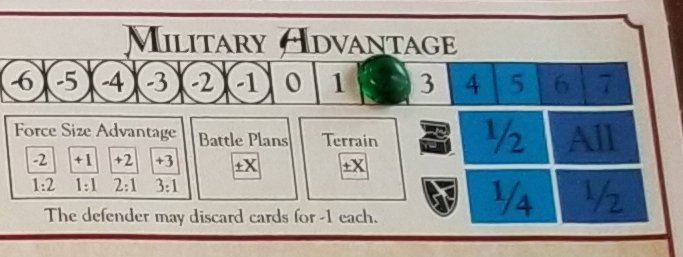
While combat looks complicated, it basically boils down to a series of pluses and minuses that dictate if you get a minor or major success (light or dark blue zones respectively).
I absolutely cannot cut to my final thoughts about Oath without mentioning the most novel of all design concepts in the demo I played: the “map”. Massive air quotes here, because Oath doesn’t really use a map, per se, but I don’t know what else to call it. If you’ve read the developer diaries, then you know where I’m going with this. Depending on who wins and where their power base is seated, the location the game is centered around for your next game, the Cradle as it’s called, changes. This affects the distances your player pawn has to travel to go from location to location, whether within the same zone or between them, and how much “effort” (the game’s action currency) you’ll pay to do it. It’s a genius system that conveys perfectly how difficult it is to move depending on where you are and where you’re going, yet can also adapt to any configuration of where the game ends and to where the focus shifts. Players will be able to pack these locations back into the box with dividers to preserve things as needed between sessions as their world grows.
The Shine Of Design
I first started writing this article with the intention of focusing on feelings and reactions rather than rules. The game is still evolving, and rules may experience changes before the final release. Still, to really understand what makes Oath special, I realized you need to understand a little bit of those rules so you can see how they all interact in magical ways. The chancellor can invite other players to join the citizen team with them. Can all four players become citizens, turning the vibe into one of a backstabbing senate? Yep! A citizen can’t hold Vision cards, but they get to peek them before they are discarded if drawn. Can you engineer a situation in which the chancellor exiles you, only so you can draw the Vision card you saw (yes, you can draw from the discard) and bamboozle yourself a win? Sure can. Maybe you can’t muster enough forces to prevail over superior numbers, but can clever tactics and positioning beat a bigger force? You bet! Anyone who’s played Pax Pamir and seen how the new edition is relatively simple in the rules but complex in the interactions will feel right at home here. When I started this piece by saying Oath gives you everything, I really meant it. This game is as close to a pseudo-Legacy political wargame sandbox as I’ve ever seen, and what it does it does darn well!
That all being said, like Cole’s other designs, this game definitely won’t be for everyone. I have a feeling that if you’re here reading this, you’re already a lover of games like the aforementioned Root and Pax Pamir. But Cole did make a point of saying to me that this game is mean. Again, not that this is a bad thing, as he’s also stated this game’s continuing format makes for some great stories that come out of backstabs or kingmaking. While these things typically make for bad blood in boardgames, in the case of Oath they actually seem to enhance the experience, a lot like rolling failures in TTRPGs help to enrich a story. Just know that you’re getting into a brutal game that encourages players to get in each other’s faces and pull some really dastardly deals with those deliberately delinquent. If your empire gets a well-timed knife in the back, getting the chance to see how your new exiles respond in the next game is a very satisfying promise.
With that said, the game isn’t terribly hard to learn. In Cole’s own words complexity rests around “like teaching 1.5 to 2 Root factions.” That is, a little more complex per player to pick up, but less complicated to play overall. I realized within one turn around the board that while there were lots of rules to keep track of, they all made sense contextually in the theme. In fact, the game was shockingly easy to slide into! Clear attention has been given to making sure mechanics and theme correspond, and the game retains that Cole Wehrle style of cleanliness in the design and components, even unfinished as it is never overloading me with too many bits at once. Cole says they regularly play games in about an hour, maybe less if someone gets a quick Vision win. If the game goes short, you can shuffle up and play the next chapter. If it goes longer, you can pack it away for the next time. The deck is also seeded for the next session as part of cleanup, so while teardown time is still pretty quick overall, setup should clock in at 3 minutes or less.
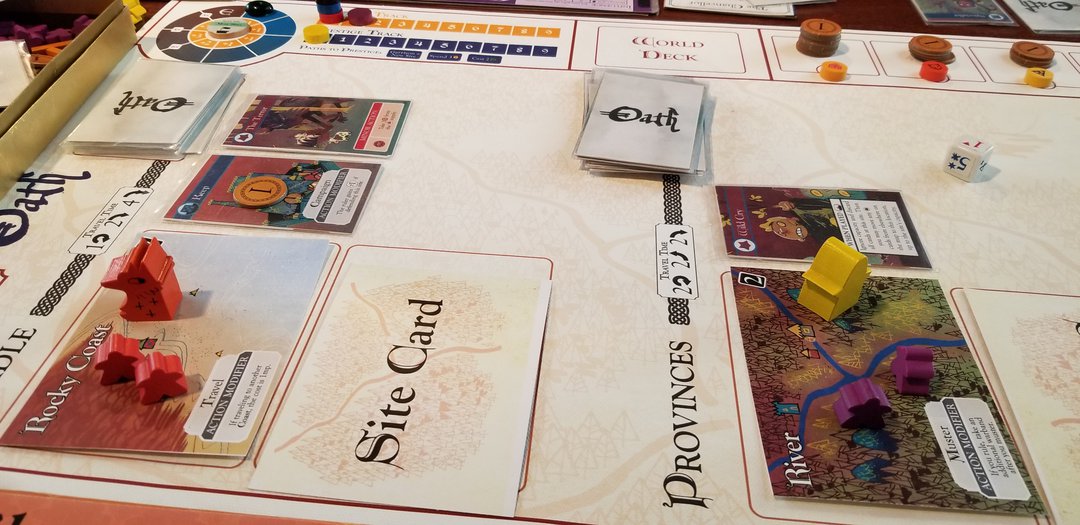
In this shot, the yellow player is the chancellor. All citizens share purple armies matching their player boards, the reverse side of which (denoting exile) has their original player color. Streamlining this is one of those things still being considered in development.
After Walking Away
If I came away with one overarching impression from my time with Oath, it was this: trust. Cole is the kind of designer who constantly examines and reexamines his intentions when making a game, if those intentions are still coming through like they’re meant to, and if things need to be radically ripped up in order to get to the heart of the game he’s seeking. He’s so clearly focused on refining every aspect of his designs several times over that the final products often appear so clean as to be effortless. The truth is anything but. The colorblind accessibility of the pieces, the way the main board and player boards can fit on a coffee table, the streamlining of bits to minimize fiddliness, all easily overlooked in the grand sweep of this game’s flow, are honed purposefully. Even after a very limited time demoing Oath, I can say that this design shows once again that level of refinement in the details. I could honestly shut myself out from ever reading another designer diary and I would still trust that the final product would have as much polish as I’ve come to expect from every game of Cole’s I’ve ever played. I see that same dedication here once again.
I’ll remind everyone in closing that this isn’t a review. This isn’t a how-to-play. This isn’t an endorsement for everyone to rush out and back the Kickstarter when it goes live (though I certainly hope you keep an eye for it if you’re still interested). This is one person’s opinion on impressions after a couple hours’ worth of explanation and play of an unfinished design. This game is brutal. There will be groups of gamers that loathe all the hype around another game by Cole all about the shifting of empire and power, what the support of different factions means to different people, and where good play is as determined by how you play the other players as by any solid tactics within the game itself. Though I will say I think players get more agency in their own defense through play mechanics here than they do in Root. I predict that those gamers will still be just as confounded about what all the fuss is when they see Oath for themselves. And that's ok. No game fits every gamer, and Oath may not be a game for those crowds. If on the other hand you’re the type who’s excited by shifting power balances, well-timed backstabs, and the sweeping scope of an ever-changing political landscape, along with the possibilities of “what happens next” each game, I think you’ll be just fine. I’ve never seen anything quite like Oath, and that makes it very special in my eyes. Hopefully now you see a little of what I have, and for better or worse, it’s informed you that little bit more. If you’re still interested, keep your eyes peeled in the near future. 2020 is just around the corner!